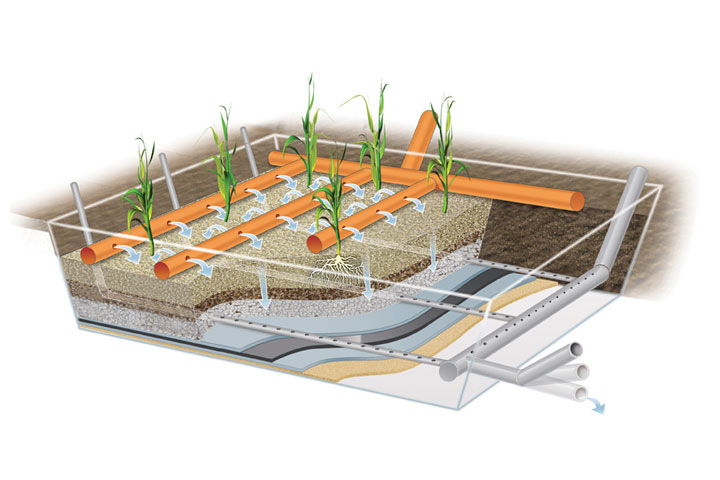Ecosafe services related to Constructed Wetlands
Constructed Wetlands are natural treatment systems for wastewater and sludge. They represent an innovative, sustainable method in the field of ecological engineering and technology (eco-tech) with multiple technical, economic and environmental benefits.
Compared to conventional treatment methods, Constructed Wetlands possess advantages like:
– reduced investment cost – reduced operation cost up to 80%
– reduced energy consumption up to 90%
– no use of complex and extended mechanical equipment
– no need for specialized staff to run the facility
– enhancement of the green corporate profile and of the corporate social responsibility.
Ecosafe provides integrated solutions to cover the needs of each customer, like:
– sampling taking and water/wastewater characterization
– experiments for the determination and optimization of the system performance with the use of pilot-scale beds for specific/industrial wastewater
– design and studies of Constructed Wetland facilities
– licensing, construction and management of Constructed Wetland projects
– supervision and maintenance program of Constructed Wetland facilities
– monitoring, sampling taking, chemical analyses and evaluation of the treatment performance
– R&D (Research & Development)
Our company develops partnerships and collaborations with research centers, institutes, universities, companies in the same field internationally and industrial/market bodies for the determination of the optimum technological solution and for the exchange of experience and expertise. We participate in national, European and international research projects and conferences which bring together industrial, research and market partners.
In Ecosafe we study and design each application separately, based on the customer needs and the wastewater type and origin, aiming at providing the optimum Constructed Wetland solution in terms of technical efficiency and cost-effectiveness.

Constructed Wetlands represent the optimum solution for on-site treatment of domestic and municipal wastewater.
Specifically, they can be used for:
– single households, maisonettes, residential complexes. Especially in regions where no sewer network exists or septic tanks are used and regular emptying of the tank is needed, Constructed Wetlands provide a direct and economic alternative
– hotels, resorts
– enterprises, business office buildings for treatment of wastewater produced from staff-customers
– small-medium settlements, villages, communities, municipalities
– settlements in remote, mountainous, rural, insular regions
– upgrade and/or expansion of existing conventional treatment plants (e.g., as tertiary stage)
– collection and treatment of urban runoff, combined sewer overflow, highway runoff
Constructed Wetlands can be applied in a variety of wastewaters with industrial origin for their on-site treatment. Each industrial process produces pollutants of different nature and at varying concentrations. Industrial wastewaters demand a detailed characterization before the selection and design of the appropriate treatment chain. Constructed Wetlands can be applied in various industries like:
- Construction industry, Chemical industry, Metallurgy, runoff and drainage frommines.
- Contaminated groundwater in industrial areas, e.g. at refinery sites (hydrocarbon removal).
- Runoff/drainage from gas storage facilities for methanol removal.
- Pharmaceutical, tanning, textile industries.
- Leachates/drainage from Sanitary Land filling sites.
- Polluted runoff from airport runways.
- Polluted runoff at sites of industrial plants, factories and distribution centers.
- Food- andagroindustry: olive mills, dairies, cheese dairies, wineries, livestock farms, piggeries, slaughterhouses, washing waters.
Management of sludge produced in conventional activated sludge plants or in drinking water plants is a major problem, due to the huge daily amount of excess sludge. Treatment of excess sludge includes also, among others, its volume reduction before the final discharge and/or reuse.
Sludge Treatment Wetlands represent an ideal and economic solution for the on-site management of excess sludge at Wastewater Treatment Plants of municipalities, communities, companies etc.
The main benefits of Sludge Treatment Wetlands are the small investment, the minimum operation and maintenance cost, and the production of a final well composted and stabilized sludge material bio solids which can be exploited as fertilizer, soil amendment etc.
In contrast to the conventional mechanical methods (e.g. filter presses, centrifuges), energy consumption is minimum and takes place only for the sludge pumping. With Sludge Treatment Wetlands, the final sludge volume is reduced at a rate above 90%, with physical filtration which removes almost 100% of the total solids. After 8-12 years of operation, the solid content in the biosolids exceeds 50%, the biosolids are removed and a new feeding cycle begins.
